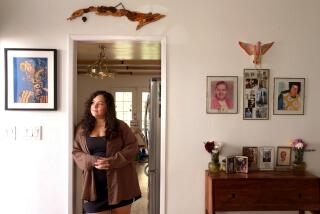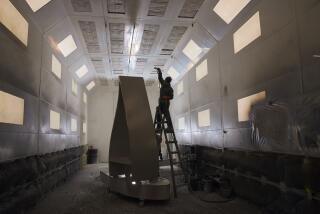Training Gives Inner-City Youths Hand Up : Program: Intensive automotive instruction and life-skills course add up to full-time jobs for graduates.
- Share via
LOS ANGELES — At the Kim Hankey Hyundai dealership here, 20-year-old Elias Salas buries his head under the hood of a blue Excel SE. Born and raised in South Central Los Angeles, Salas is a graduate of one of the first successful training and job placement programs to aid inner-city youths in the wake of last year’s riots.
The program is also receiving widespread recognition as a successful public/private partnership between industry and education that is being examined carefully for transport to other cities and industries.
“What they gave me might have taken another two years in college and five years experience on the job,” Salas says as he tinkers with hoses and gauges. As a member of the first class of “Hyundai Academy,” Salas spent 18 weeks in intensive, eight-hours-a-day technical training beginning in July, 1992.
The pilot program is a compressed version of a previous program that took two years to complete. Salas earned 12 hours of college credit at no cost to him, while providing Hyundai Motor America Inc. with a needed service technician.
Besides learning his way around carburetors, radiators and electrical components of new model cars, Salas took a “life-skills” course to prepare him for the ways of the world--from getting along with peers and bosses to understanding other ethnic groups.
The additional skills learned there, he says--including how to interview, write resumes, project positive attitudes and generally excel--have helped land him and all 25 of the other graduates full-time paying jobs after graduation.
“The academy is unique in that it teaches students much more than how to turn a wrench,” says N. Douglas Mazza, executive vice president and chief executive officer of Hyundai Motor America, which is headquartered in Fountain Valley. “We’re interested in moving youth beyond the mechanics of a skill to the mechanics of a career.”
The Hyundai Academy was developed by the Orange County company--the U.S. importing, dealer development and marketing arm of South Korea’s Hyundai Motor Corp.--as executives in Fountain Valley began looking for a steady source of trained service personnel in the wake of Hyundai’s first few years of blistering sales in this country.
Before increased competition, the recession and a spate of early quality control problems began taking their toll in 1990, Hyundai had set a record as the fastest-selling import car ever launched in the United States.
In 1986, its first year selling in this country, Hyundai sold 160,000 cars in America. By 1988, the total swelled to 260,000. This year, Hyundai expects to sell about 125,000 cars.
But in the face of its early sales successes, Hyundai Motor America found its four factory training facilities overloaded with technicians who already worked for various dealers. It had no room for entry-level trainees.
So a pilot program was set up at Los Angeles Harbor College to see if the in-house training program could be transferred to a campus. Hyundai Motor America donated $100,000 for the program, which began in September, 1991, and was less than half completed when the Los Angeles riots erupted in April, 1992.
Hyundai officials said they decided to institute a compressed schedule for inner-city trainees to help answer the pressing need for jobs as demonstrated by the civil unrest.
Because he was the top student in the first graduating class from the program, Salas won an all-expense-paid, one-week trip to South Korea to visit the world headquarters of Hyundai in Ulsan.
“For those of us who experienced the riots, it’s easier to understand the motives for a program like this,” Mazza says. His company now has invested about $10,000 in each of the 25 Hyundai Academy graduates.
“Hyundai is the largest Korean corporation, and we recognized we had to step up and participate in healing the tensions,” Mazza says. He notes that much of the hostilities during the rioting were between Koreans and blacks.
“Hyundai has been a leader in meeting the job-training needs of the inner city with this innovative program,” says Bernard Kinsey, co-chairman of Rebuild L.A., a non-governmental coalition formed in the wake of the riots to attract businesses back to the community.
“Hyundai’s commitment to the community and our nation’s youth . . . is highly commendable . . . during these trying times in California,” says Democratic Rep. Matthew G. Martinez, whose district includes parts of South Central.
“I would like to encourage other companies to follow Hyundai’s example of a successful industry-education partnership that really works,” adds Rep. Walter Tucker (D--Compton). Getting other companies to follow the Hyundai model is, in fact, one of the company’s current goals.
Hyundai officials have met with U.S. Labor Secretary Robert Reich, who has expressed interest in expanding apprenticeship programs to other industries. Company officials have presented Reich with curriculum studies and independent evaluations from the National Automobile Dealer Assn., as well as industry consumer satisfaction indexes.
“What we are doing is not specific only to the auto industry; it can and should be replicated in others,” Mazza says. “Rather than expect the government to create apprenticeship programs on its own, the best idea is for private enterprise to get involved to put people in the private sector.”
The program goes beyond Hyundai’s self interests, says Pete Egus, manager of the Hyundai Academy. “It’s also a way for schools to get alternative funding and keep their curriculum current by hooking up with industries who need trained employees,” he said.
In his 18-week course, Salas studied all aspects of engine performance, transmissions, air conditioning and electrical and mechanical components. He also became licensed by the state of California to perform smog-emission checks. He says part of the best training came in working with people of different age groups and different ethnic groups.






